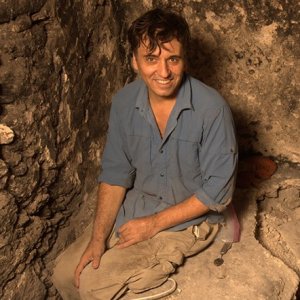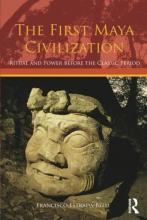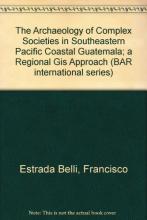Francisco Estrada-Belli
Research Assistant Professor

Biography
Francisco Estrada Belli (Ph.D., Boston University), specializes in Maya archaeology, Remote Sensing and Geographic Information Systems. He is a fellow of the Society of Antiquaries of London and a National Geographic Explorer. He is the author of “The First Maya Civilization. Ritual and Power before the Classic Period” (Routledge, 2011) the first book on the origins of Maya civilization since 1977. He directs a multi-disciplinary archaeological project in the Holmul region of Peten, Guatemala, focusing on early developments of Maya civilization, human-environmental dynamics and Classic period political organization. He co-founded the Maya Archaeological Initiative, a non-profit organization that promotes research and youth education on Maya heritage. He is one of the co-directors of Guatemala’s Pacunam Lidar Initiative, the largest archaeological survey ever undertaken in the Maya lowlands.
Education
Boston University
Links
Articles
Ancient lowland Maya complexity as revealed by airborne laser scanning of northern Guatemala
Lidar (a type of airborne laser scanning) provides a powerful technique for three-dimensional mapping of topographic features. It is proving to be a valuable tool in archaeology, particularly where the remains of structures may be hidden beneath forest canopies. Canuto et al. present lidar data covering more than 2000 square kilometers of lowland Guatemala, which encompasses ancient settlements of the Classic Maya civilization (see the Perspective by Ford and Horn). The data yielded population estimates, measures of agricultural intensification, and evidence of investment in landscape-transforming infrastructure. The findings indicate that this Lowland Maya society was a regionally interconnected network of densely populated and defended cities, which were sustained by an array of agricultural practices that optimized land productivity and the interactions between rural and urban communities.
A King's Apotheosis: Iconography, Text, and Politics from a Classic Maya Temple at Holmul
Excavations at the ancient Maya city of Holmul, Petén, have led to the discovery of a building decorated with an intricately carved and painted plaster frieze. The iconography of the frieze portrays seated lords, mountain spirits, feathered serpents, and gods of the underworld engaged in the apparent rebirth of rulers as sun gods. Large emblems carved on the side of the building identify the structure as a shrine for ancestor veneration. A dedicatory text carved along the bottom of the frieze contains a king list and references to the political and familial ties of the ruler who commissioned the temple. Together, the iconography and text of this structure provide evidence of function and meaning. They also shed new light on a century during Classic Maya history known as the Tikal “Hiatus,” for which a limited number of texts are available. The information derived from this monument also broadens our understanding of the nature of hegemonic relationships among Classic Maya states.
A 3400 year paleolimnological record of prehispanic human–environment interactions in the Holmul region of the southern Maya lowlands
The timing, magnitude and drivers of late Holocene environmental change in the Holmul region of the southern Maya lowlands are examined by combining paleoenvironmental and archeological data. Environmental proxy analyses on a ~ 3350 cal yr lacustrine sediment record include pollen, charcoal, loss on ignition, magnetic susceptibility, and elemental geochemistry. Archeological evidence is derived from extensive settlement surveys conducted near the study site. Results indicate nearby settlement and agricultural activity taking place in an environment characterized by open forest from around 3350 to 950 cal yr BP. The fire history shows a dramatic increase in burning during the Classic period, possibly reflecting changing agricultural strategies. A distinct band of carbonate deposited from 1270 to 1040 cal yr BP suggests decreased hydrologic input associated with drier conditions. Abrupt changes in proxy data around 940 cal yr BP indicate a cessation of human disturbance and local abandonment of the area.
A Maya Palace at Holmul, Peten, Guatemala and the Teotihuacan “Entrada”: Evidence from Murals 7 and 9
Excavations at La Sufricaya, a minor ritual group in the outskirts of the Lowland Maya city of Holmul, have documented two mural paintings inside an elite building of Early Classic date (A.D. 300–A.D. 600). One of the paintings is mythological in nature (Mural 9). The second bears an inscription with references to calendrical and historical events. It commemorates a notorious arrival date at Tikal on 11 Eb 15 Mak (January 16, A.D. 378) on its first anniversary. The architecture and artifacts associated with the murals combine Maya and Teotihuacan decorative motifs, and offer several parallels with Tikal assemblages. The iconography, epigraphy, and archaeological associations of these murals are discussed in relation to the function of the palace complex. This important new evidence contributes to an understanding of which role relations with Teotihuacan may have played in regional politics in the Maya Lowlands during the Early Classic period from the point of view of a smaller site. The interpretations presented here focus on the concept of political intervention of Tikal in the affairs of secondary and tertiary sites.
LIGHTNING SKY, RAIN, AND THE MAIZE GOD: The Ideology of Preclassic Maya Rulers at Cival, Peten, Guatemala
Research in the northeastern Peten region at Holmul and nearest minor centers shows a complex history of public ritual activity from the Middle Preclassic onward. Patterns of public architecture, monumental sculpture, iconography, caches, and burials at sites such as Holmul and Cival document early development of the ideology of Maya kingship. Late Preclassic monumental sculptures adorning large pyramid temples provide immediate and elaborate metaphors for the ancestral patrons of emerging dynasts. Middle Preclassic architecture and caches are encoded with the ideological program of the earliest ruling institutions, incorporating themes of cosmological order; sun, water, and maize deities; the agricultural cycle; and ancestor veneration. All of these early remains are found in the sacred space of the first “E-group” plazas.
Media Appearances
Exclusive: Laser Scans Reveal Maya "Megalopolis" Below Guatemalan Jungle
“LiDAR is revolutionizing archaeology the way the Hubble Space Telescope revolutionized astronomy,” said Francisco Estrada-Belli, a Tulane University archaeologist and National Geographic Explorer. “We’ll need 100 years to go through all [the data] and really understand what we’re seeing.”
Secret Mayan tombs lend rare insight into rule of mysterious 'snake kings'
One tomb is a vaulted chamber, built into a pyramid that was constructed to surround an older, fifth-century building. Inside was the skeleton of a middle-aged person whose teeth had jade inlays, a custom of Maya royalty, and an inscribed human tibia, “a very, very rare find”, archaeologist Francisco Estrada-Belli told the Guardian.
Giant Maya Carvings Found in Guatemala
Maya archaeologist Francisco Estrada-Belli and his team were excavating a tunnel left open by looters when they happened upon the frieze. "The looters had come close to it, but they hadn't seen it," Estrada-Belli said.



